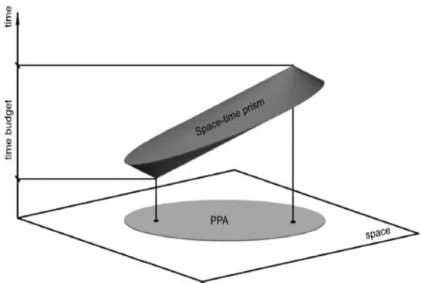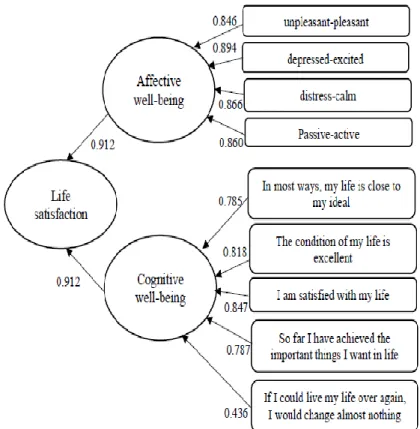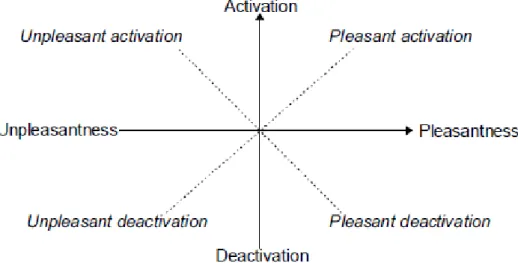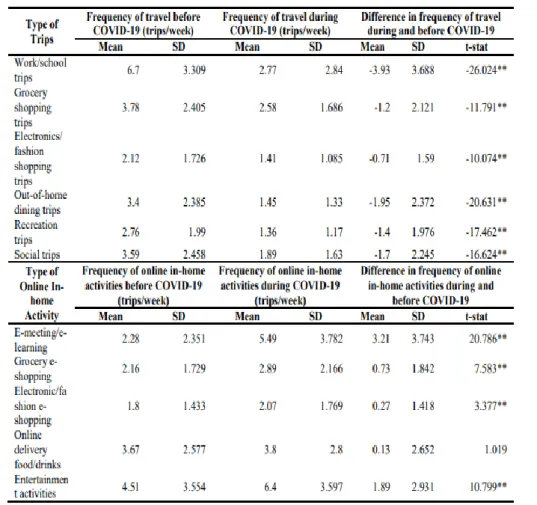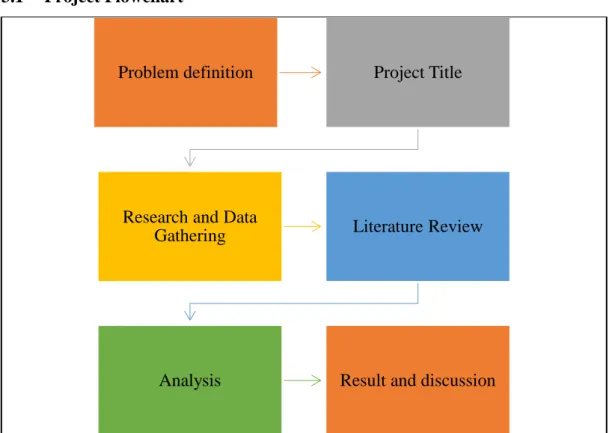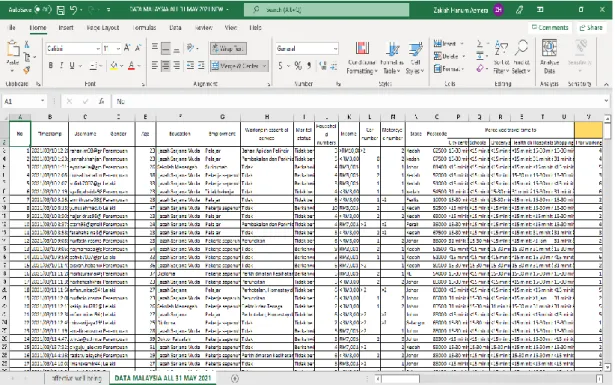Effects of changes in social travel, discretionary travel and activities during the Covid-19 pandemic on emotional well-being. The 2019 outbreak of COVID-19 affected various countries around the world, forcing national, provincial and local governments to implement extensive travel restrictions in the interest of public health. Therefore, this study is of particular interest to analyze the changes of social travel and discretionary travel during the COVID-19 pandemic on emotional well-being.
An online survey was conducted in Malaysia (N=438) to investigate the effects of the COVID-19 pandemic on travel behavioral activity as well as affective well-being.
Background Study
Some of the activities are outdoor activities, so traveling is one of the life needs of people to fulfill their needs and desires. During the pandemic, people are less inclined to socialize and take discretionary travel due to the mobility restrictions imposed by the government. These sudden changes with having limitations for outdoor activities in their daily lives have been seen to affect the affective well-being and mental health of individuals as some activities are essential to maintain or improve people's affective well-being.
Thus, once current restrictions are relaxed, it is expected that leisure activities outside the home (eg, socializing and discretionary) will be undertaken more frequently to improve overall well-being and mental health.
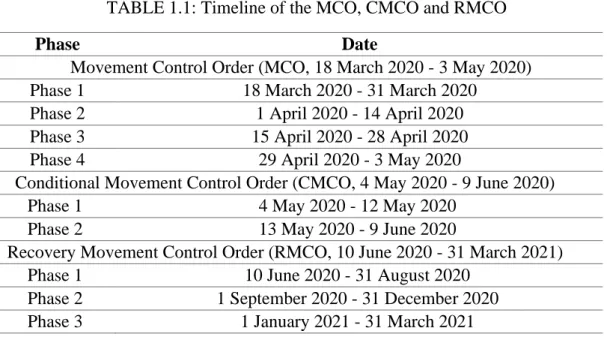
Problem Statement
However, this research is still in its early stages and many of the complex relationships between travel behavior and well-being remain unexplored; most studies examine only one component of this link (i.e. travel satisfaction) (Vos, Schwanen, Acker, & Witlox, 2013). As taking social and discretionary travel and activities tends to correlate with better well-being and social and mental health (Dharmowijoyo, 2020), this study will provide insight into the effects of changes in social travel, discretionary travel and activities on affective well-being - during the COVID-19 pandemic, taking into account the complexity of travel behaviors that are overlooked in travel-based analyses, including household and individual socio-demographic characteristics, the activity-travel pattern of different individuals (including multitasking) and well-related questions. To correlate the effects of changes in social travel and discretionary travel during COVID-19 pandemics on affective well-being using the bivariate analysis method.
To correlate the effects of changes in social travel and discretionary travel during the COVID-19 pandemic on affective well-being using multivariate analysis.
Scope Of Study
- Types of Constraints
- Space-Time Path
- Space-Time Prism
- Time Geography of Well-Being
Temporal geography is concerned with determining an individual's freedom of action in the face of multiple spatial and temporal constraints, rather than directly predicting travel behavior (Neutens et al., 2011 as cited in Rizka et al., 2020). Valence is a purely hedonic measure of well-being that quantifies how someone feels about an event, service, or choice, while activation refers to energetic activation or mobilization. The protagonist of well-being is said to be multifaceted and encompasses both cognitive and emotional well-being (Schwanen & Wang, 2014).
The term "cognitive well-being" refers to the assessment of one's life satisfaction over an extended period of time. The two main affect dimensions or axes according to Russell (1980), as cited in Västfjälll et al. 2000), representing degrees of pleasantness–unpleasantness and arousal. Satisfaction with an individual's leisure life domain, one of several subdomains of their existence, has a beneficial influence on their subjective well-being through a bottom-up spillover process (Kuykendall, Tay & Ng, 2015).
According to the American Psychological Association, during the COVID-19 pandemic in 2021, people would feel increased stress and unexpected limitations in their everyday responsibilities (Heid et al., 2021). Individuals in the COVID-19 condition have a limited pool of leisure activities and leisure companions, leading to numerous leisure time restrictions (Du et al., 2020). It is also stated that the capacity and flexibility to properly control emotional responses has been linked to well-being in recent decades (Hu et al., 2014).
It shows that the average response to respondents' emotional well-being was greater than neutral (3 represents neutral) or agreeing that they are in a negative state of emotional well-being. Feelings of frustration and depression during an outburst were found to be the lowest state of emotional well-being, indicating that respondents were able to cope with the situation. But whether someone is dissatisfied with the experience during the pandemic showed a neutral value (3.06), indicating their indifference (Rizki, et al., 2020).
Surprisingly, online entertainment activities were the most frequently performed activities throughout the outbreak, with the second largest difference after work/school activities (Rizki, et al., 2020).
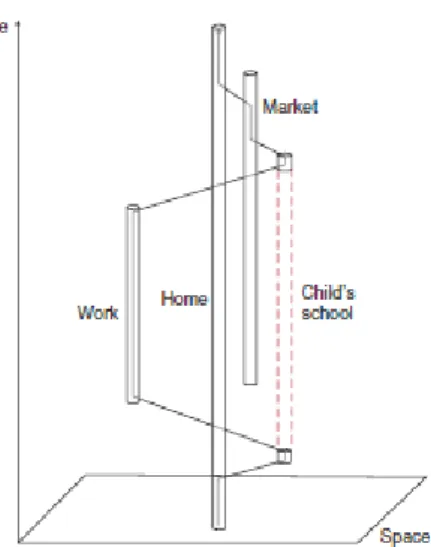
Project Flowchart
Methods of Information Collection
Sepanjang Mei 2021, tinjauan keratan rentas berasaskan dalam talian bertajuk "Tinjauan Kesan Pandemik COVID-19 terhadap Tingkah Laku Aktiviti Perjalanan di Malaysia" telah dijalankan di Malaysia. Untuk memastikan pengedaran dan pengambilan peserta secara besar-besaran, orang dewasa yang bersetuju berumur 20 tahun ke atas telah direkrut secara elektronik menggunakan kaedah persampelan mudah dan bola salji. In this study, the samples were drawn from states in Malaysia: Johor, Kedah, Kelantan, Kuala Lumpur, Labuan, Melaka, Negeri Sembilan, Pahang, Perak, Perlis, Penang, Putrajaya, Sabah, Sarawak, Selangor and Terengganu.
The online questionnaire was developed using the Google Forms platform and the created survey form was converted to a web link. It was distributed through various social media platforms (Facebook, Instagram, Twitter, Line and WhatsApp), and thus can avoid face-to-face interaction during the survey, which is not safe during the pandemic.
Survey questionnaire
A total of 438 participants completed the questionnaire and their answers were recorded in the analysis. Social activities and subjective well-being questions were asked in the fourth section of the survey. The subjective well-being questions consist of nine emotional well-being states ranging from negative valence (unpleasant experiences), deactivation (passive and dull), a combination of negative valence and activation (frustrated, bored, irritated, and anxious), and the combination between negative valence and deactivation (depressed and tired).
Questions such as how much physical pain participants are experiencing, how they feel about their health, mental health and other health issues during the pandemic. In most sections, seven-point Likert scales were used to record participants' responses.
Data Input, Interpretation, and Analysis
Overall Affective Well-Being during COVID-19 Pandemic
An index of affective well-being was obtained from factor score analysis with varimax rotation of all survey questions related to the survey using principal components analysis with a one-factor solution. Factor score analysis is commonly used to reduce a large number of variables to fewer factors. The factor scores also produce multidimensional information factor loadings that show the interrelationships between multidimensional information variances with respect to discretionary and socializing trips during the pandemic and overall emotional well-being.
These scores are then classified as high affective well-being or low affective well-being. Positive scores indicate a high level of affective well-being, while negative scores indicate a low level of affective well-being. The factor score analysis results are then analyzed by drawing a graph of the average of individuals who had high and low affective well-being during PKP/PKPB and PKPP.
For low affective well-being, the average affective well-being of individuals during PKP/PKPB and PKPP is -0.76 and -0.73, respectively. When PKPP is compared to PKP/PKPB, there is an increase in respondents' overall affective well-being. More people have high affective well-being during the PKPP, while fewer people have low affective well-being.
This is due to the fact that some movement restrictions are alleviated during PKPP compared to PKP/PKPB, where mobility restrictions are more severe.
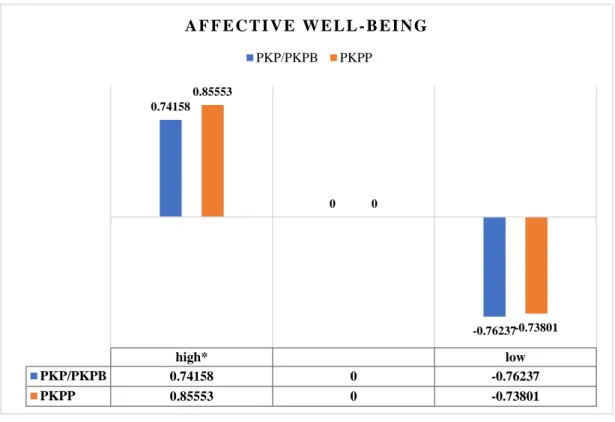
Bivariate Analysis of Individuals’ Travel Behaviour and The Effect to The Affective Well-Being
During PKP/PKPB
People who took higher trips during PKP/PKPB generally have higher affective well-being than those who took a similar number of trips and higher trips during PKP for both trips. Under PKPP, as observed in Figure 4.4, for grocery trips, dining trips, sports trips, and health care trips, individuals who took higher trips before PKPP have higher affective well-being compared to those who took higher trips during PKPP and to those who took a similar number of trips under the PKPP. For social trips, those who took higher trips during PKPP had higher affective well-being (0.168) than those who took higher trips before PKPP (1.163) and those who took a similar number of trips before and during PKPP (0.604) .
In most categories (grocery trips, social trips, sports trips), the highest affective well-being was found in the people who took higher trips during PKPP. Second, higher affective well-being came from the people who took more trips before PKPP, and the lowest affective well-being came from the people who took a similar number of trips before and during PKPP. The lowest affective well-being still comes from the people who took similar trips before and during the PKPP.
As a result, their limited time budget has affected the frequency with which they travel during the CPPP, affecting their affective well-being. Travel for socializing, sports, and health care has the most significant impact on affective well-being during the COVID-19 pandemic. People also have fewer restrictions during the CPPP making them have sufficient social engagement without affecting affective well-being.
This evidence suggests that e-grocery activity does affect affective well-being during the COVID-19 pandemic. However, for the other activities, the p-value is not statistically significant, indicating that the independent variables have no effect on affective well-being.
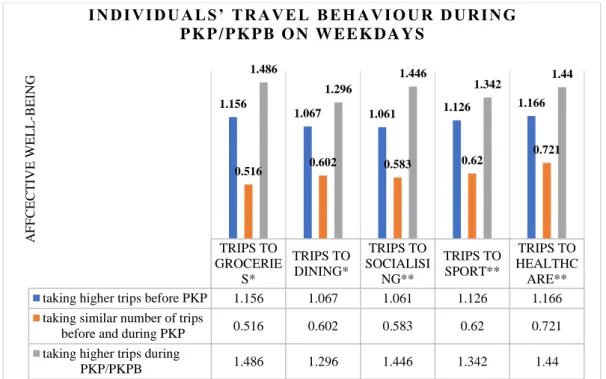
5 CONCLUSION AND FUTURE WORKS
Conclusion
Future Works
Optimism and depression as predictors of physical and mental health functioning: A study of normative aging. The effect of messaging and gender on intentions to wear a face covering to slow the transmission of COVID-19. Mobility and health: interaction of activity and travel patterns, general well-being, transport-related social exclusion on health parameters.
Gröndal M, Ask K, Luke TJ, Winblad S (2021) Self-reported impact of the COVID-19 pandemic, affective response and subjective well-being: A Swedish study. Daily travel behavior and emotional well-being: Effects of travel mode, duration, purpose, and companionship.
